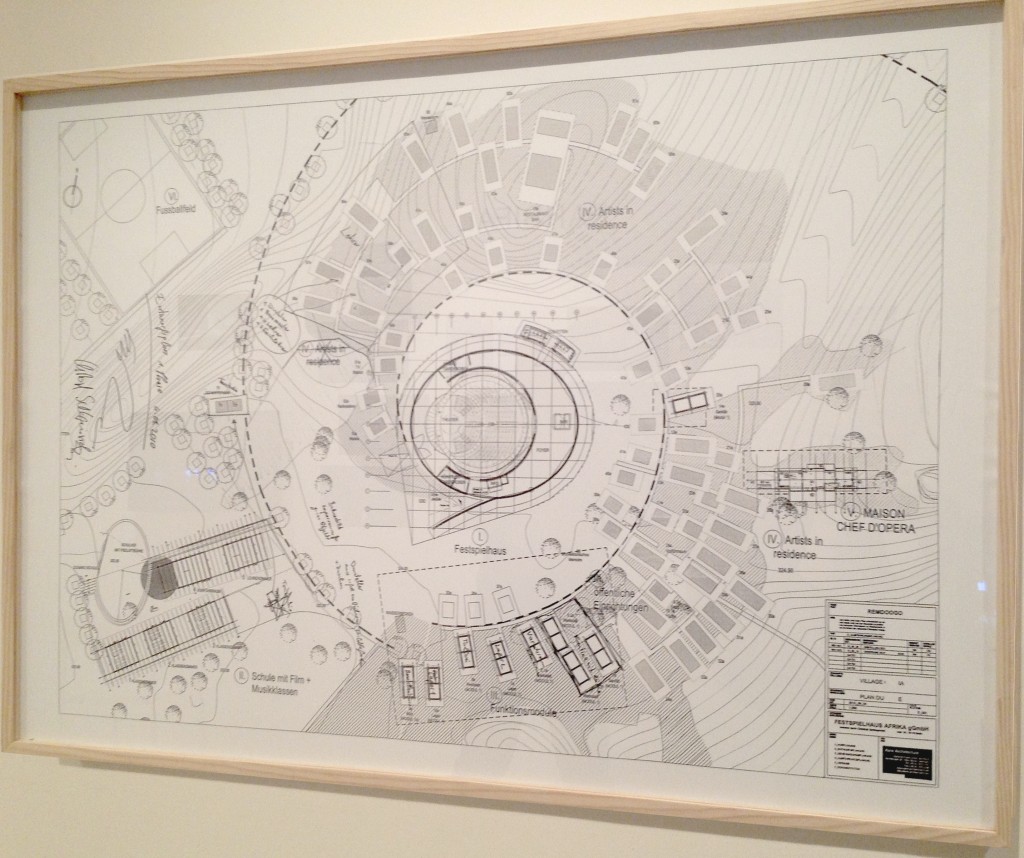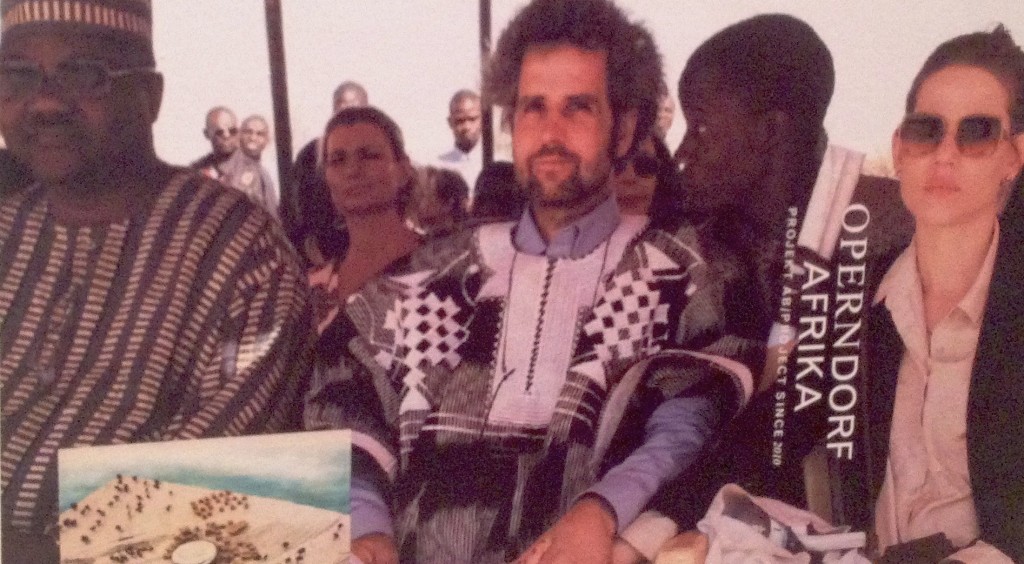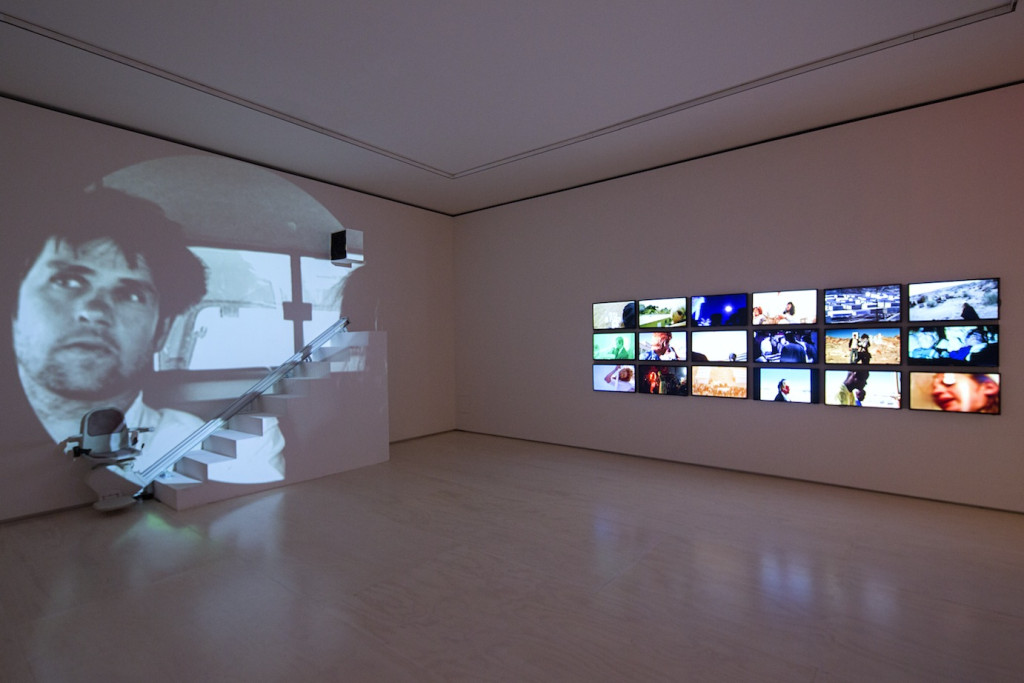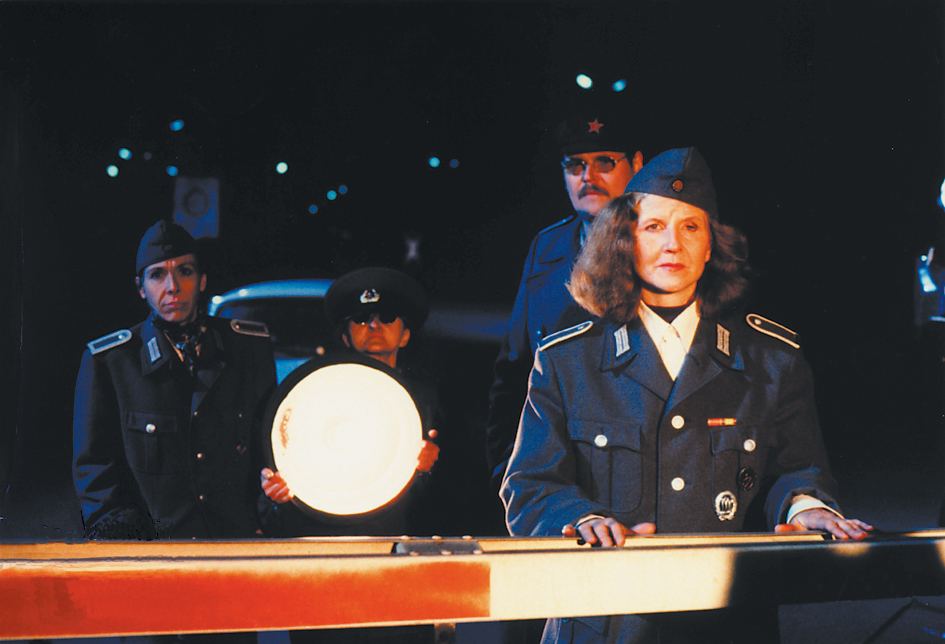The first comprehensive survey of Christoph Schlingensief in the US
Christoph Schlingensief (1960-2010) was a multi-disciplinary artist who worked for thirty years at his craft until his untimely passing from cancer at fifty years old. Much of his career and notoriety occurred in Europe and in 2011 he represented Germany in the 54th Biennale di Venezia where he posthumously won the Golden Lion. The installation, titled “A Church of Fear vs. the Alien Within,” (2008) was a monumental, three-dimensional prayer, the work of a man who was aware of his own mortality and oncoming death. Film, sculpture and an installation that invited the public basically into the mind of a man who was contemplating his life as he approached death. It was a church, bathed in red, a liturgy, a memorial and an artwork.
In 2011 on the occasion of the exhibition in Venice, Aino Laberenz, the artist’s widow stated,
“The films were very important to us because they show how Christoph’s work began. It was not intended as a complete retrospective, but as an introduction to the Schlingensief universe on the basis of two lines of suffering, Germany and cancer, and on the basis of an optimistic outlook for Africa. Suffering and salvation.” (quote from Death In Venice: Resurrecting Schlingensief At The Biennale, www.schlingensief.com).
For the 2014 exhibition at MoMA PS1 organized by Director Klaus Biesenbach with assistance from Aino Laberenz who also functions as Artistic Advisor and representative of the Estate of Christoph Schlingensief, multifarious projects are on view offering a wide range of work from the Schlingensief opus. Included are a series of films that function instrumentally as soundboards, political flair and an homage to the stylistic musings of German filmmaker Rainer Werner Fassbinder (1945-1982). In the films, characters representing all facets of life, death, and the sordid parts of society that many don’t want to talk about. A lubricious underbelly is present in devious yet somehow playful figures that roam his visceral settings channelling war, sexuality and political satire and in doing so projects the way that power is extradited and administered as a way to control a larger contingency of the public. Along with the films that are on view are a series of objects, collages, and video clips from other theatrical interventions within the public sphere that were realized by Schlingensief. All of his previous artwork and theatrical proposals paved a road which lead to the eponymous project which commenced in the process of realization just before his death in 2010, the Opera Village in the tiny African country, Burkina Faso. The Opera Village is an ongoing work that was fostered by Schlingensief and is still being executed by Laberenz. The goal of the village as an artistic proclomation, invoking the physical structure of buildings and an organization of functional space. Schlingensief was aware of the stereotypes that were and are widespread and he wanted to construct a place for artistic exchange and the development of theatrical tradition, not necessarily impending on the existing traditions but rather facilitating venues for further cultural exchange.
Aino Laberenze was recently on location at MoMA PS1 for the exhibition and we had a brief dialogue while standing in front of her former husband’s work, the din of protests in the streets, culminating in chaos and action, documented and created moments, like the Opera Village, where life and art collide.
Katy Diamond Hamer: I wanted to start with asking you about Christoph’s legacy and your role in fulfilling his artistic wishes, including the Opera Village, which you have facilitated since his death.
Aino Laberenz: The progression from his death to rising to the occasion in order to stimulate construction of The Opera Village was really fast. I started to work with Christoph together directly on this in 2009. We initially started by scouting different countries in Africa as possible locations. We were searching for a place where we’d be able to build something like this and in a way envelope it. We arrived in Burkina Faso, a country with a spectrum of art. We were always interested in war, conflict and issues of hunger and in Burkina Faso, it is all there. Christoph had an interest in the power of art and dismissing the fact that people couldn’t see eye to eye. From the beginning I recognized this need for intervention in Christoph and found it to be very brave. He wanted to make a very concrete and personal project in Africa that would create an exchange between us and some people there and it has been very interesting for me as well. I wouldn’t say that it’s his project solely, but it also belongs to me and the African people. It’s not easy to set up a situation like this architecturally, politically and artistically. It’s been hard to get money to fund all of the extensive efforts. Christoph was an artist and a leader while I was and am behind the scenes. We’ve found a struggle with the monetary realization and not the conceptual realization.
KDH: In 2011, the project introducing the Opera Village was presented in Venice at the German pavilion, underneath the installation “A Church of Fear vs. the Alien Within,” (2008), it seemed as if most of the structure of the village had been built. Is that the case?
AL: Actually there was almost nothing. When we started and we had to bring water, etc. Christoph saw fundamental properties and nothing more. Many of the photographs that document the project and are on view here (at MoMA PS1) were taken in September 2013, so a little more has been added to the construction since then, but not much. We have over twenty buildings, all which have come to fruition under my direction. Christoph never saw them built. We have a school, about 150 children attend the school on a daily basis. This is all my work. If we look at the intricate plans that Christoph made for the village, we can see it is in the shape of a snail. He wanted it to always feel open, and for those present to be enveloped rather that enclosed with walls.
KDH: Part of this plan is to also create an artist’s residency at some point?
AL: Yes, this is part of the plan, to encourage exchange with artists. Christoph did a piece, a theater piece, with artists from Burkina Faso. It was at the time he had just started to build the plans for the village, he constructed [site-specific] workshops. In the last two years, I’ve also worked only with African artists in the residency, so as not to overwhelm the locals with what feels too German or too white and to have their acquaintance with the process grow slowly. A big part of this project the act of listening and looking around, to observe and not inform or instruct people. Our future goal is to have the artist’s in residence interact with the villagers versus document what is going on or show them what art is.

Christoph Schlingensief, Detail of plan from the Opera Village, 2010-Present, MoMA PS1, NY, Photograph by Katy Hamer, 2014
KDH: Taking inspiration from the spiral, it seems as a project that it will never truly “end” but is the process of construction almost finished?
AL: What you see here –gesturing to the documentation installed in the exhibit- is a cafeteria, stocked with a kitchen, there is a sound studio, a school (as mentioned above), some buildings for the teachers and the actual opera still needs to be built as Christoph specifically wanted it to be the last building made.
KDH: Have the people who live there been cooperative?
AL: Yes, it’s really interesting because the people of Burkina Faso were the focal point of the project and Christoph (who had quite a lot of fame in Germany) was very happy that no one knew who he was. They are not only a part of it, it is an Opera Village. It is not a Christoph Schlingensief project. There are borders and it isn’t just about a German or African view, but the goal is to understand certain countries and help everyone understand each other. Sometimes, I don’t even know if I can ever bring the project to fruition since I am coming in from another country and don’t even know much about Germany. I want to be able to be able to share and be interesting to others without the pretense of expectation.
KDH: Congratulations on all of this as an expansion of thought becoming reality. Within my scope, there hasn’t been an American artist who has made work like this. The idea and the concept of art is treated as a malleable and invisible form that moves within the political sphere and scope of the public realm yet can also exist in the context of a museum.
AL: This was really the point, as you can see Christoph, was working between the categories of art and life and he always ventured beyond borders and looked at art as a free space that could be accessed, like a direct relationship to language. You’ll see in this exhibition, that his work isn’t about something you can hang on the wall but it is about content and extreme. This project is the peak where he was looking for art in-between art and reality. We are excited to have this show in NY and see the reaction of how people will respond.

Christoph Schlingensief and Aino Laberenz, 2010, Burkina Faso, Photograph detail from installation at MoMA PS1, NY, 2014
Christoph Schlingensief is on view at MoMA PS1 in Long Island City, Queens (a short train ride from Manhattan or Brooklyn) from March 9–August 31, 2014.
More soon
xo


